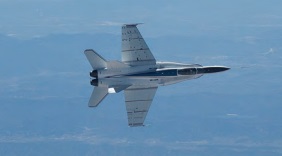Chapter: Avionics and Instrumentation Technologies, new invention technology, Research project papers,
Distributed Aerostructural Sensing and Control

Distributed Aerostructural Sensing
and Control
Armstrong
researchers are investigating ways to increase aircraft maneuverability,
safety, and fuel efficiency by applying networks of smart sensors distributed
across an aircraft. This 'fly-by-feel' concept could enable a vehicle to
autonomously react to changes in aerodynamic and structural conditions.
Distributed pliable membrane sensors obtain real-time information and convert
it into aerodynamic information that can be used for adaptive flight control. In
comparison with conventional sensing technologies, which measure aerodynamic
parameters from only an aircraft's fuselage, these smart sensors enable
localized measurements at nearly any surface on an aircraft structure. The
ultimate goal is to feed real-time sensor information into a control scheme
such that the aircraft can autonomously control the position
of a surface appropriately for active
aeroelastic wing control.
Work
to date: The team has conducted sensing and analysis
work with hot-film sensors installed on Gulfstream III, F/A-18, and
X-56A aircraft.
Looking
ahead: Next steps involve more investigative work
with the X-56 aircraft, specifically hot-film sensors combined with
fiber optic strain sensing and associated data fusion algorithms to address
distributed sensing and control applications.
Partners: Texas
A&M University, California Institute of Technology, Illinois
Institute of Technology, University of Minnesota, Air Force
Material Command, Air Force Research
Laboratory, and Tao Systems, Inc.
Benefits
High-performance: Offers
certifiable performance and stability guarantees and aerostructural
efficiency
Improved safety: Provides
localized data, enabling engineers to be more confident that design
specifications offer appropriate safety margins
Applications
Aircraft testing and design
Improved drag
reduction and increased lift performance
Active aeroelastic control of flexible
structures
Avionics and Instrumentation Technologies
Armstrong innovators design and integrate data
acquisition systems for research, support, and one-of-a-kind platforms. In many
cases, these systems leverage commercial off-the-shelf parts to keep costs low
and ease integration with legacy systems. At the same time, these cutting-edge
data systems are finding innovative ways not only to collect data efficiently
but also to flexibly configure collection parameters.
Designed for aerospace applications, many of
these innovations can benefit numerous industries in a variety of situations
where data optimization is critical, such as manufacturing operations, business
processes, and energy management, to name a few.
Related Topics